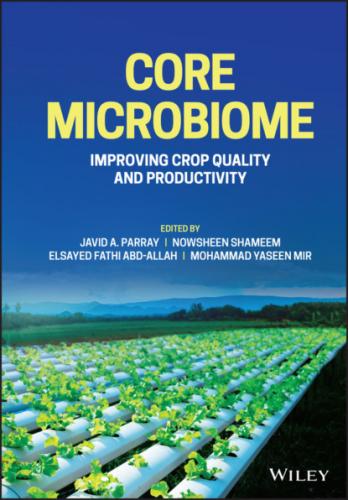3.7 Biological Control and Plant Improvement
Plant–microbe interaction proves to have increased plant growth directly by stimulating nutrient availability or hormonal production or indirectly by suppressing plant pathogens. Many rhizobacteria strains, such as Bacillus group, Taphylococcus, and Burkholderia cepacian, promote plant growth. These strains also produced volatile organic compounds (VOCs) that enhance growth (Bitas et al. 2013). Biosurfactants, VOCs, antibiotics, and enzymes are used to suppress the growth of pathogens (Berg et al. 2010). Plant extract with antifungal activity is used to suppress pathogens and increase the growth of medicinal plants. Medicinal plants effectively control the development of diseases caused by Macrophomina phaseolina. It is also reported that medicinal plants exhibited varying degrees of inhibition activity against M. phaseolina. Different concentrations of Cleome viscose, Hyptis sueolences, Grewia arborea, Avicennia officinalis, Ocimum, Tephrosia villosa, Peltophorum pterophorus, Sesbanian grandiflora, and Terminalia chebula showed high activity with strong antifungal activity against M. phaseolina, while chloroform extracts showed very low activity (Bobbarala et al. 2009).
Biological compounds produced by medicinal plants depend on microbes, plant interaction, plant and microbe species, and soil types (Morsy 2014). These metabolites produced by medicinal plants have a strong effect on biological and physiological pathways and help them withstand harsh environments. Solanum distichum, Matricaria chamomilla, and Calendula officinalis showed an antagonistic effect in the bacterial rhizosphere (Köberl et al. 2013). Ajuga bracteosa is a medicinal plant used to cultivate diverse root-associated bacteria for plant growth promotion. About 123 different morphological bacteria were isolated from soil and roots. The results predicted in the majority of isolates showed plant growth promotion due to the production of IAA and siderophores (Kumar et al. 2012). Plant growth-promoting rhizobacteria activities include the production of IAA, contributing to phytohormone-regulating plant growth, while siderophores can solubilize iron and make it available for plants. Moreover, the chitinase enzyme that can lyse pathogenic fungal cells inhibits pathogens. Phytochemicals produced by plants affect plant–microbe interaction (Qi et al. 2009). Greater antimicrobial activity was observed in Hypericum plant extract that protects endophytes as compared with Ziziphora that showed lesser antimicrobial characteristics. Moreover, methanol extract exhibited strong antibacterial activity against Bacillus subtilis, E. facecalis, and S. aureus. Chelidonim majus L. and much potential against fungal pathogens (Baker and Satish 2013).
3.8 Management Strategies to Alleviate Abiotic Stress in Medicinal Plants
Various bacterial genera can promote plant growth and are known as plant growth-promoting rhizobacteria (PGPR). Moreover, scavenging of ROS, the compatible solutes, and accumulation of antioxidant metabolites are induced signals for important transcriptional modulation activities under heat stress (Wahid et al. 2007). Most endophytic actinomycetes belong to the genus Streptomyces, which is responsible for about 80% of biologically active compounds. Actinomycetes protect medicinal plants by reducing the growth of fungal pathogens with chitinases acting as inhibitors of fungal growth. The use of endophytic actinomycetes for controlling S. rolfsii offer an eco-friendly environment and disease management (Nagpure et al. 2014). IAA has a role in stem elongation and root growth. The IAA value is high in the rhizosphere, where rhizosphere bacteria produce auxin as secondary metabolites because of rich supplies of root exudates. It also triggers the propagation of lateral roots that increase the nutrients-absorbing area, which leads to better assimilation of water and nutrients from the surroundings.
Actinobacteria also produce IAA, cytokinin’s and gibberellic acid. Aspergillus and Streptomyces produce a high level of IAA, which leads to the production of hematophagous actinomycetes (Ruanpanun et al. 2010). The application of rhizobacteria improves plant growth as well as soil microbial activity (Karami et al. 2010). With nourishment from microbes in the stress environment and adaptable response at the phenotypic level, it is always appropriate to implement microbe-derived natural products that can perform a good job to alleviate stress regardless of environmental conditions.
3.9 Conclusion and Future Consensus
Medicinal plants have been gaining much importance in developing countries due to the re-emerging health concerns from the rising costs of prescription drugs for maintaining personal health. A WHO report stated that about 80% of people rely on herbs. The quality of medicinal plant products is affected by biotic and abiotic stresses. Microbes in the soil improve medicinal plant growth and quality, which explains the increasing research interest in medicinal plants and their interaction with rhizosphere microbes for crop improvement, withstanding abiotic stresses. PGPR are a great option to improve the quantity and quality of medicines and plants. However, it mainly depends upon the selection and identification of bacteria, streptomycetes, fungi, and microbes and their interaction with plants that could help improve growth and withstand harsh environmental conditions as well as high-quality secondary plant metabolites production. Plants react to different stresses, and microbe-based mitigation approaches necessitate studies for gaining a deeper insight into the molecular, physiological, biochemical, and ultra-structural composition. These studies require different approaches, i.e. genomics, metagenomics, and molecular proteomics for a clear understanding of behind-the-scenes plant–microbe
